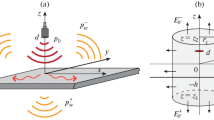Abstract
The behaviors of the amplitude of shear displacements and the angle of injection of elastic vibrations have been studied as functions of the frequency and geometry of electromagnetic-field transmitters via a numerical analysis based on the direct electromagnetic-acoustic transformation (EMAT) phenomenon described earlier. The presented data are analyzed with an approximate expression for the difference scheme of sound emission. It is shown that, as the frequency increases, the displacement amplitude reaches a maximum and then decreases. As the frequency increases, the angle of vibration injection abruptly decreases until the frequency of stabilization of the radiation-maximum position is reached and then becomes virtually frequency-independent when the values approximately corresponding to the radiation far-field zone are reached. Expressions are derived for the depth of the end of the radiation near-field zone and the conventional beginning of the radiation far-field zone. It is shown that, in the case of the difference radiation scheme corresponding to two-phase transmitters, the boundaries of both zones during EMAT are shifted from the surface to a distance corresponding to the ratio of the average diameter of the transmitter to the width of the emitting element.
Similar content being viewed by others
References
Lependin, L.F., Akustika (Acoustics), Moscow: Vysshaya Shkola, 1978.
Komarov, V.A., Magnetostriction Electromagnetic-Acoustic Transformation in a Normal Polarizing Field, Defektoskopiya, 2004, no. 3, pp. 56–68 [Russ. J. Nondestruct. Test. (Engl. Transl.), no. 3, pp. 178–187].
Budenkov, G.A., Development of the Theory of Ultrasonic Methods and Creation of Means for Testing Rapidly Moving Hot Products, Doctoral (Techn.) Disertation, Chelyabinsk: Chelyabins. Polytechn. Inst. im. Leninskogo Komsomola, 1981.
Gurevich, S.Yu., Fundamentals of the Theory and Practical Application of High-Temperature Ultrasonic Testing of Ferromagnetic Metal Articles, Doctoral (Techn.) Disertation, Yekaterinburg: IFM UrO RAN, 1996.
Muzhitskii, V.F., Remezov, V.B., and Komarov, V.A., Fundamentals of Electromagnetic-Acoustic-Transformation Thickness Measurements with Attachable Probes: 1. Direct Electromagnetic-Acoustic Transformation in a Normal Polarizing Field, Defektoskopiya, 2006, no. 10, pp. 40–58 [Russ. J. Nondestruct. Test. (Engl. Transl.), no. 10, pp. 667–681].
Muzhitskii, V.F., Remezov, V.B., and Komarov, V.A., Direct Electrodynamic Electromagnetic-Acoustic Transformation in a Normal Polarizing Field. I. Dependence on the Gap According to the Spectral Theory, Defektoskopiya, 2007, no. 8, pp. 40–52 [Russ. J. Nondestruct. Test. (Engl. Transl.), no. 8, pp. 40–52].
Skuchik, S., Osnovy akustiki (Fundamentals of Acoustics), Moscow: Mir, 1976, vol. 2.
Komarov, V.A. and Muzhitskii, V.F., Teoriya fizicheskikh polei (Theory of Physical Fields), Part 1: Elektromagnitnoe pole (Electromagnetic Field), Izhevsk: RIO UDGU, 1997.
Author information
Authors and Affiliations
Additional information
Original Russian Text © V.F. Muzhitskii, V.B. Remezov, V.A. Komarov, 2007, published in Defektoskopiya, 2007, Vol. 43, No. 8, pp. 53–64.
Rights and permissions
About this article
Cite this article
Muzhitskii, V.F., Remezov, V.B. & Komarov, V.A. Direct electrodynamic electromagnetic-acoustic transformation in a normal polarizing field: II. Acoustic field of the transition radiation zone. Russ J Nondestruct Test 43, 532–541 (2007). https://doi.org/10.1134/S1061830907080050
Received:
Issue Date:
DOI: https://doi.org/10.1134/S1061830907080050



